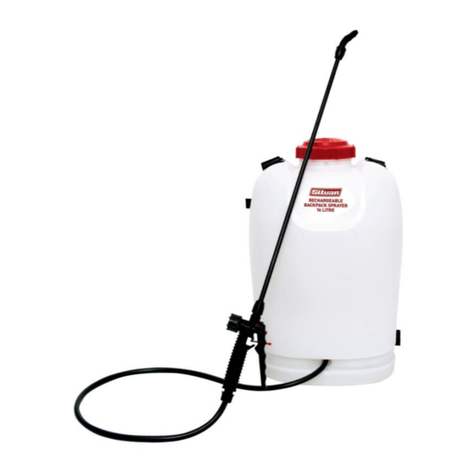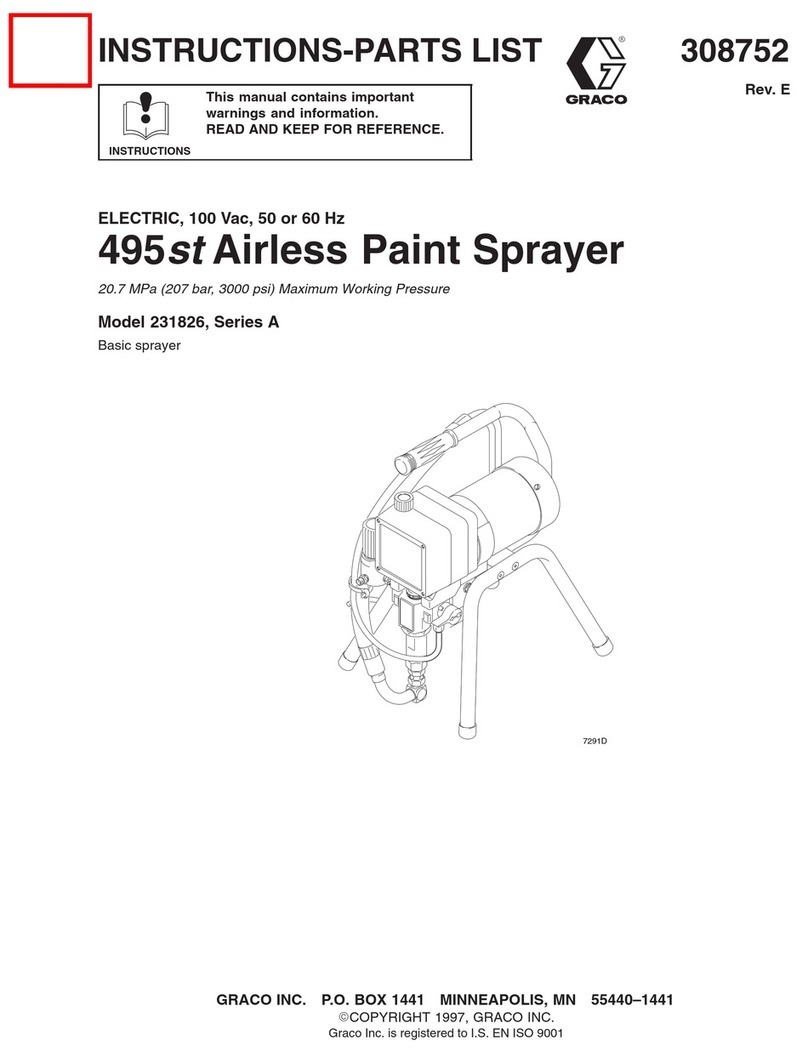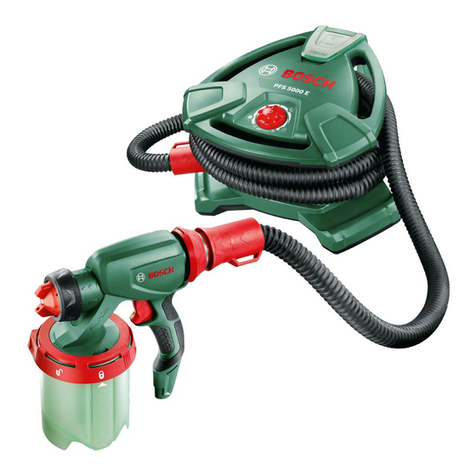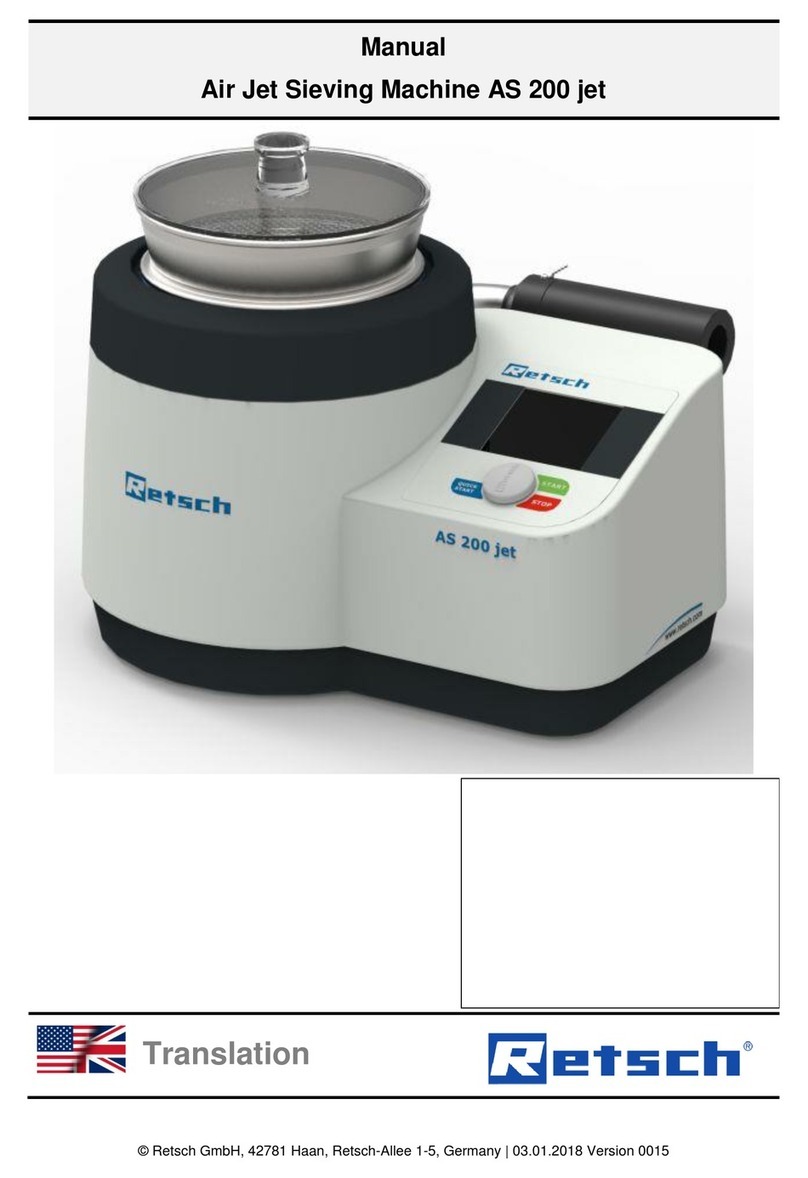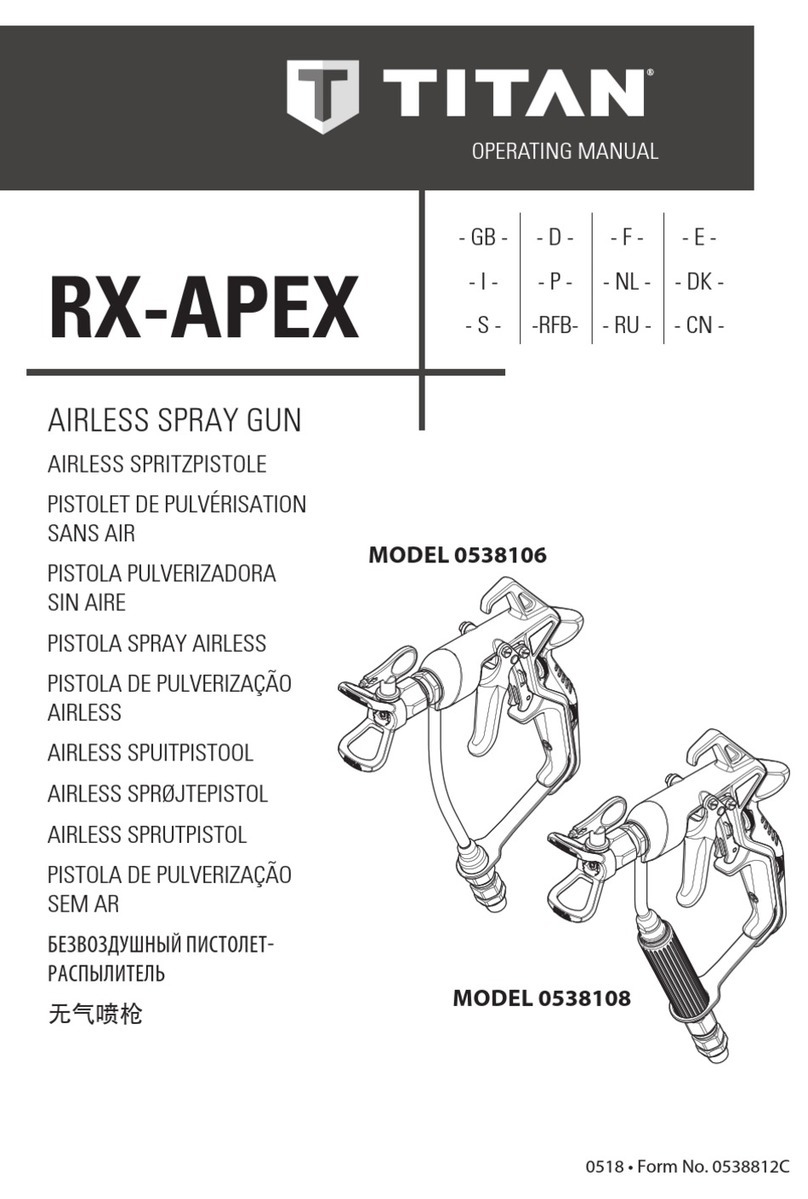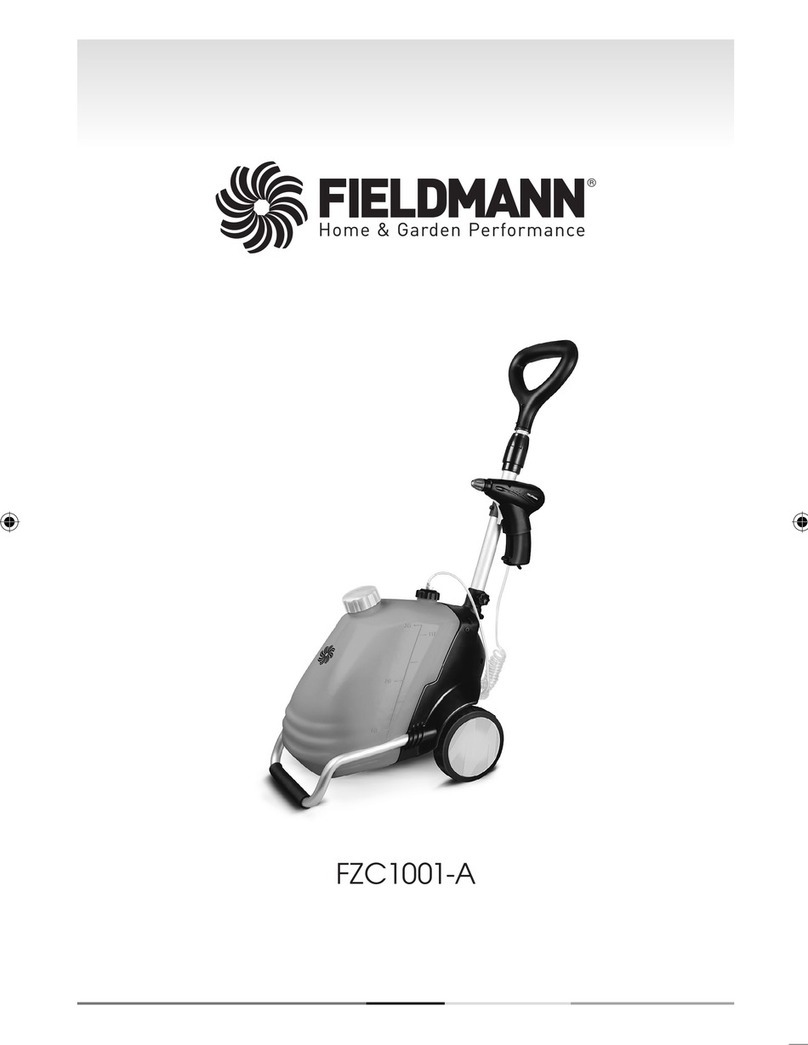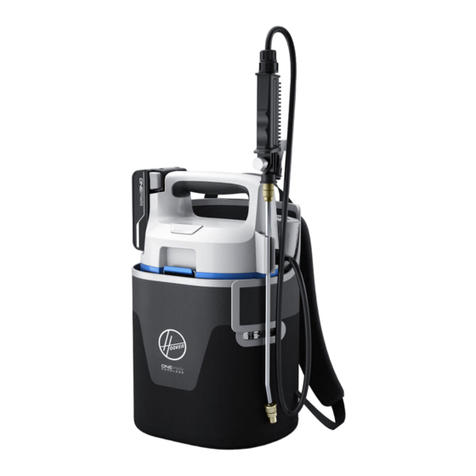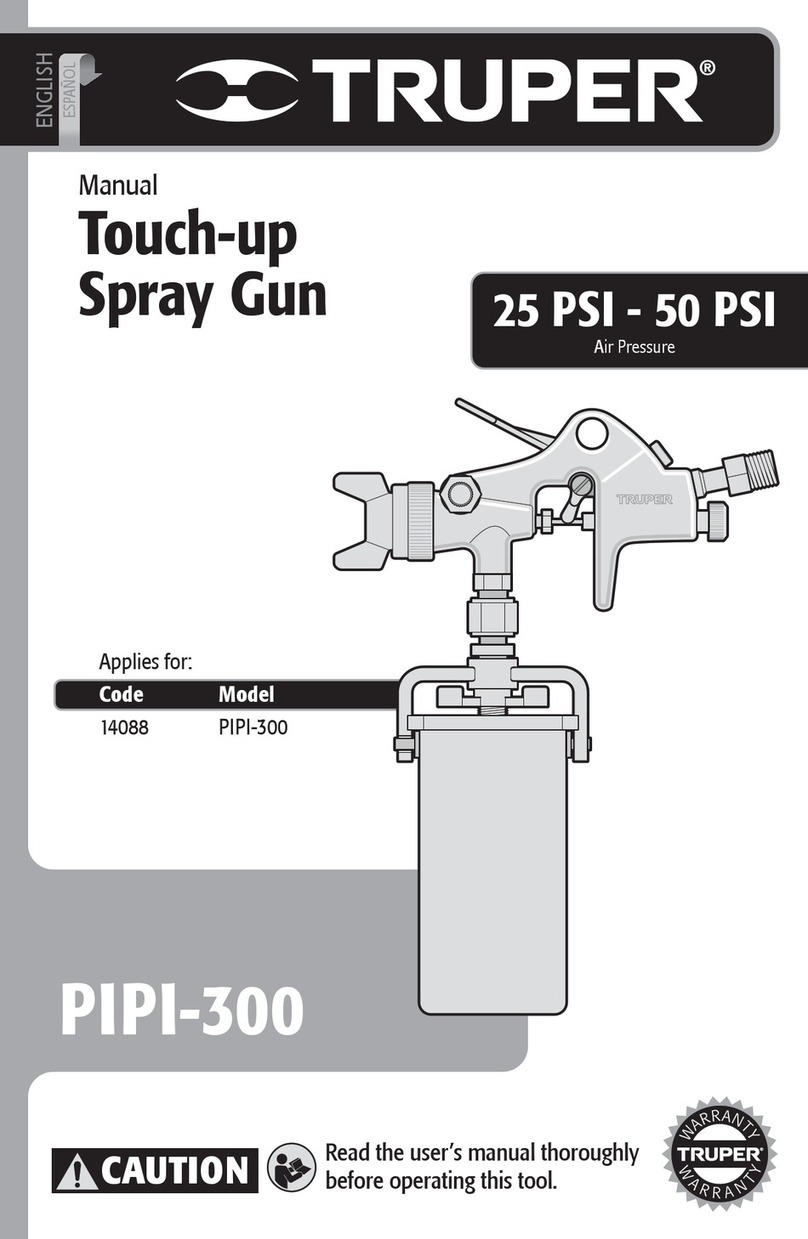Smith Industrial and Contractor Series User manual

Do Not Return This Sprayer To The Store
For Help, Information or Parts, Call : 1-800-311-9903
The Fountainhead Group, Inc.
23 Garden St., New York Mills, NY 13417
1-800-311-9903
www.TheFountainheadGroup.com
www.smithperformancesprayers.com
CAUTION: Read and follow all instructions
Use and Care Manual
Poly Industrial
Compression Sprayer
Manual No. 183281
Rev A: 05/18/17
ECN16-072
5 1/2”X 8 1/2”Booklet
Industrial and Contractor Series
R301
#190451

Do not return sprayer to store, if you experience problems or have questions contact
our toll free Customer Service Center, M-F 8A.M. - 5P.M., EST, at 1-800-311-9903, or
SAFETY PRECAUTIONS
• Read owner’s manual completely before operating this sprayer.
• Always use goggles, gloves, and protective clothing when using sprayer. Refer to the appropriate
technical bulletin for the chemical being sprayed for additional protective clothing required.
• Read and follow all instructions and cautions on label, material safety data sheets and technical bulletins
of products used in this sprayer.
• Never use ammable liquids, caustics, acids or hot water in the tank for the R301 Sprayer.
• Do not leave sprayer in the sun when not in use.
• Spray when air is calm to prevent drift of chemicals.
• Do not use sprayer near open ame or anything that could cause ignition of the spray.
• Always inspect hose and all hose connections before each use. A damaged hose, or loose hose
connection can result in unintended exposure to the pressurized chemical, resulting in serious injury or
property damage.
• Do not lift or carry sprayer by the hose, shut-o valve, or extension. Carry by pump handle only,
making sure handle is properly locked in place before lifting.
• Do not pressurize with any mechanical device such as an air compressor, since this can create a
dangerous pressure level and bursting of parts resulting in serious injury. Only use original pump.
• Do not store chemicals in this tank.
• Always release pressure when sprayer is not in use and before removing pump from tank.
• Do not stand with face or body over top of tank when pumping or loosening pump, to prevent pump or
solution from striking you, resulting in serious injury.
• Clean and rinse sprayer thoroughly after each use.
• Never attempt to alter sprayer from original condition.
• Always use replacement parts from original manufacturer.
• Keep the sprayer and all chemicals out of the reach of children.
WARNING
The sprayer is operated with liquid under pressure. Failure to observe caution and to follow instructions
for operating and cleaning can cause tank, hose and other parts to be weakened and rupture under
pressure. This can result in serious injury from high pressure discharge of liquids or forcible ejection of
parts. Do not use ammable materials in any sprayers covered by this manual. Material could ignite or
explode, causing serious injury and/or possible death. For safe use of this product, you must read and
follow all instructions before use.
TEST SPRAYER WITH WATER BEFORE USING ANY CHEMICALS.
CAUTION
Always empty, clean and dry tank, pump system, shut-o, hose, and extension after each use. FAILURE TO
DO SO MAY WEAKEN SPRAYER COMPONENTS, CAUSING COMPONENTS TO RUPTURE WHEN PRESSURIZED.
Additionally, FAILURE TO CLEAN AND PROPERLY MAINTAIN YOUR SPRAYER WILL VOID MANUFACTURER’S
WARRANTY.
WARNING
ALWAYS CLEAN THE SPRAYER AND SHUT-OFF THOROUGHLY AFTER EACH USE
OR WHEN CHANGING APPLICATIONS AS DESCRIBED IN THE CLEANING SECTION.
FAILURE TO COMPLETELY CLEAN MAY CAUSE CROSS-CONTAMINATION.
Page 2

ASSEMBLY INSTRUCTIONS
Assemble Hose To Tank
IMPORTANT: Do not attempt to heat or alter hose,
hose nut, or barb prior to assembly.
1. Align hose barb tabs, push hose barb into tank
until it stops (See Figure A).
2. Slide hose nut into place and turn clockwise to
tighten. (See Figure B).
NOTE: Do not use tools to tighten hose nut.
Figure A Figure B
Page 3
XR Valve
Assemble Hose, Extension, Shut-O & Nozzle
1. Attach hose to Shut-O and tighten securely using a 9/16”Wrench, use a 3/4”Wrench to hold the Shut-O
handle while tightening the hose. (See Figure H)
2. Install the extension onto the Shut-O assembly and tighten the nut securely using a 13/16” wrench.
(See Figure J)
3. Install selected nozzle into the extension nut and tighten nut securely using a 13/16”wrench. Insert check
valve if required as shown. (See Figure K)
Figure H
Figure J Figure K
80° FAN .07 GPM #4 GREEN
80°
80°
80°
80°
SPRAY
ANGLE: SPRAY
PATTERN:
FAN
FAN
FAN
FAN
FLOW
RATE:
.10 GPM
.13 GPM
.10 GPM
.20 GPM
COLOR
#6 RED
#10 BLACK
#8 GRAY
#12 BROWN
65° FAN .2 GPM
80°
80°
80°
95°
SPRAY
ANGLE: SPRAY
PATTERN:
FAN
FAN
FAN
FAN
FLOW
RATE:
.2 GPM
.5 GPM
.4 GPM
.5 GPM
110° FAN 1 GPM
BRASS FLAT FAN TIP
NOZZLE USES: CERAMIC CONEJET TIP
NOZZLE USES:
1. Industrial and Concrete Series (Orange)
Used on 1. Turf and Argiculture Series (Green)
2. Industrial and Concrete Series (Orange)
3. Cleaning and Restore Series (Blue)
4. Pest Control Series (White)
Used on
BRASS ADJUSTABLE
FAN NOZZLE USES:
1. Industrial and Concrete Series (Orange)
Used on

Page 4
OPERATING INSTRUCTIONS
Filling
IMPORTANT: Always make sure the pressure is
released from the tank before lling or servicing.
1. Pull up on the knob of the pressure release
valve until all the pressure is released from the
tank. (See Figure P.)
2. Turn the pump handle counterclockwise to remove
the pump (See Figure R).
3. Fill the tank to the desired level. See ll markings
on side of tank. (Always refer to chemical
manufacturer for proper mixture).
4. Install the pump into the tank opening and turn
clockwise until tightly sealed against the tank
(See Figure S).
Figure S
Figure R
Figure P
Pressurizing
1. Make sure shut-o lock is not engaged. (If shut-o lock is engaged while pressurizing, the unit
will immediately start spraying).
2. Push down on the handle and turn counterclockwise to unlock the handle (See Figure T-1T).
3. Pressurize the sprayer by pumping the handle in a smooth up and down motion (See Figure T-2T).
4. Push down on the handle and turn clockwise to lock the handle into the pump (See Figure T-3T).
Figure T
1T 2T 3T
XR Shut-o Sprayer
1. Direct nozzle away from you and squeeze shut-o
lever to begin spraying.
2. This model does not have a locking handle.

Page 5
OPERATING INSTRUCTIONS CONTINUED
Steps To Cleaning Your Sprayer
*** To prevent clogging issues, after each use clean your sprayer.***
WATER BASED PRODUCTS
1. Release pressure in your sprayer via pressure relief valve. Do not undo handle without removing pressure.
2. Empty remaining chemical back into original lling container.
3. Fill sprayer with water, place pump back into tank, and tighten.
4. Aggressively shake the water in the tank to try and get residue o of the inside walls of the sprayer. Repeat
step if necessary, each time relling with fresh water.
5. Pressurize the sprayer and spray water for 30-45 seconds into a disposable reservoir, then release pressure
and remove the pump from the tank.
6. Tip and empty tank, then set tank upright. Hold wand and shut-o above the tank and depress the
shut-o. The liquid will drain into the tank, empty again.
7. Repeat the steps above as necessary.
8. Allow tank to air dry by leaving the pump outside of tank over night.
Sprayer Storage
1. Sprayer tank should be hung upside down, with the pump removed.
2. Do not store or leave any solution in the tank after use.
3. Store in a warm, dry location out of direct sunlight.
4. Keep the sprayer and all chemicals out of the reach of children.
MAINTENANCE
Pump Lubrication
Pump should be periodically oiled by applying 10 to
12 drops of light oil down the pump rod through the
opening in the pump cap as shown.
Pump Disassembly & Reassembly
NOTE: Remove pump from tank prior to disassembly.
1. Inspect gasket. If worn or damaged, remove and replace. (See Figure 1)
2. To remove pump cap from pump barrel, squeeze the tabs on the cap and pull away from barrel.
(See Figure 2)
Figure 2
Figure 1

Page 6
3. Inspect o-ring. If worn or damaged, remove and replace. Lubricate o-ring with petroleum jelly.
(See Figure 3)
4. Inspect check valve in bottom of barrel. If worn or damaged, remove and replace by pressing into
hole in bottom of barrel. (See Figure 4)
5. Insert the pump handle assembly into the barrel. Align the tabs of the pump cap with the rectangle
cutouts on the barrel. Push cap into place until the cap snaps securely into position. (See Figure 5)
Figure 3 Figure 4 Figure 5
MAINTENANCE CONTINUED
Nozzle Maintenance
1. If nozzle clogs, remove and disassemble the nozzle assembly.
2. Clean the openings of any obstructions and reassemble.
3. The brass nozzles should be cleaned with toothbrush and a detergent. Don’t use a metal brush or sharp
objects on the nozzle. For tough clogs soak brass nozzle in xylene and clean with a brush.
Gasket
O-rings & Seals
XR Shut-o Maintenance (Repair Kit)
Always depressurize sprayer before maintenance by activating
shut-o and spraying contents out.
1. Unscrew the handle from the shut-o assembly.
2. Unscrew valve cap and remove valve stem components and seals as
shown. Clean components with cool clean water.
3. Clean any debris from inside the handle and shut-o body. Check
for any wear of o-rings or seals and replace as necessary.
4. Reassemble the components as shown and tighten the handle and
valve cap securely.

Page 7
TROUBLE LOOK FOR REMEDY
Sprayer starts to spray
when pumping or sprayer
will not stop spraying
when shut-o lever is
released.
Shut-o lock is engaged.
Squeeze shut-o lever and rotate the lock
towards the nozzle as described in Spraying
and Locking section.
Sprayer leaks at pump or
sprayer does not build
pressure.
1. Dirt or debris on pump gasket
(#3F) or closure.
2. Chipped, torn, swollen, or
defective pump gasket (#3F).
3. Check valve (#3G) at bottom of
pump assembly.
4. Worn or damaged o-ring (#3D)
on piston.
1. Clean dirt or debris from gasket (#3F) or
closure.
2. Remove old gasket (#3F) and replace with
new as described in Pump Disassembly &
Reassembly section.
3. Replace if missing or damaged as described
in Pump Disassembly & Reassembly section.
4. Replace if worn or damaged as described in
Pump Disassembly & Reassembly section.
Sprayer material overows
through pump barrel or
pump handle rises when
handle is unlocked.
1. Dirt or debris under check
valve (#3G) on pump.
2. Chipped, torn, or swollen
pump check valve (#3G).
1. Clean check valve (#3G) and valve sealing
surface on pump.
2. Replace check valve (#3G) as described
in Pump Disassembly & Reassembly section.
Hose leaks at tank or
shut-o.
1. Loose hose at tank.
2. Cracked, swollen, or faulty hose.
3. Loose hose at shut-o.
1. Tighten hose nut at tank.
2. Replace hose.
3. Tighten hose at shut-o.
Sprayer is dicult to
pump.
1. Damaged piston o-ring (#3D)
2. Piston o-ring (#3D) is dry.
1. Replace piston o-ring as described in
Pump Disassembly & Reassembly section.
2. Lubricate piston o-ring as described
in Pump Disassembly & Reassembly section.
Sprayer tank leaks. Evidence of spray material
escaping from the tank. Replace entire sprayer.
Nozzle drips when shut-o
lever is released.
1. Dirt or debris in shut-o valve.
2. Damaged o-rings or seals in
shut-os (Kit #11).
1. Clean shut-o as described in Shut-o
Maintenance section.
2. Service shut-o seals as described in
Maintenance service (Kit #11).
Nozzle tip leaks, poor spray
pattern, partial spray or
complete stoppage.
1. Spray extension or nozzle
clogged.
2. Dirty or clogged nozzle tip.
1. Remove nozzle and clean as described in
Nozzle Maintenance section.
2. Clean the nozzle tip with a soft brush.
TROUBLESHOOTING

Page 8
KITS, PARTS & ACCESSORIES
1
KIT #3 (Brown)
2
3A
3C
3D
3E
3F
3G
3B
KIT #4 (Brown)
4B
4C
4A
5
12-1
BLACK HOSE
13
12-2
6
9-1 9-2 9-3 9-4 9-5
7
8-1 8-2 8-4 8-5 8-6 9-6
11B
XR Shut-o
10
11C
11E
11B 11A
11H
11G
11F
11D
KIT #11
11D
11G
11C
11E
11F
11H
11A
8-3

Page 9
KEY# PART# DESCRIPTION
182530 3 GALLON“R”TANK
(INCLUDES KEY #2)
2 182495 VITON PRV ASSEMBLY
(Color Brown)
1
3A 182257 “R” PUMP HANDLE
3B 182219 PUMP CAP
3C 180278 PUMP ROD
3D 180429 VITON PUMP PISTON ASSEMBLY
3E 182220 UNIVERSAL PUMP BARREL
3F 178039V “R” PUMP GASKET (Brown)
3G 171015V CHECK VALVE, VITON (Brown)
KIT #3 182413 “R” PUMP Assembly Viton
(Brown O-rings & Gasket)
KITS, PARTS & ACCESSORIES CONTINUED
KIT #4 182675 VITON PUMP SERVICE KIT
(Brown O-rings and Gasket)
4A 180429 ASSY, PISTON, VIT0N (Brown)
4B 178039V “R” PUMP GASKET, VITON (Brown)
4C 171015V CHECK VALVE, VITON (Brown)
KEY# PART # DESCRIPTION
5 181080 SHOULDER CARRYING STRAP
8
KEY# PART# DESCRIPTION
-1 182578 FLAT FAN TIP, BRASS, .2 GPM-65°
-2 176042 FLAT FAN TIP, BRASS, .2 GPM-80°
-3 176116 FLAT FAN TIP, BRASS, .4 GPM-80°
-4 176171 FLAT FAN TIP, BRASS, .5 GPM-80°
-5 182577 FLAT FAN TIP, BRASS, .5 GPM-95°
-6 182576 FLAT FAN TIP, BRASS, 1 GPM-110°
9
KEY# PART# DESCRIPTION
-1 182795 NOZZLE, #4 GREEN POLY, .07 GPM-80°
-2 182796 NOZZLE, #6 RED POLY, .10 GPM-80°
-3 182797 NOZZLE, #10 BLACK POLY, .10 GPM-80°
-4 182784 NOZZLE, #8 GRAY POLY, .13 GPM-80°
-5 182798 NOZZLE, #12 BROWN POLY, .20 GPM-80°
-6 182785 NOZZLE, #8 BRASS CONICAL
KIT #11 182906 XR, VITON,
SHUT-OFF SERVICE KIT
11A 182694 SEAL, HANDLE, VITON
11B 182693 O-RING, .073 x .75, VITON
11C 182690 O-RING, .073 x .25, VITON
11D 182689 GUIDE, BRASS
11E 182688 ASSY, VALVE STEM
11F 182692 SPRING, VALVE
11G 182691 GASKET, COPPER
11H 182695 CAP, VALVE
KEY# PART # DESCRIPTION
6 182567 NOZZLE, ADJUSTABLE, BRASS,
(Industrial and Contractor Series)
7 176332 POLY CHECK VALVE
KEY# PART # DESCRIPTION
10 182563 SHUT-OFF, XR
KEY# PART# DESCRIPTION
-1 182661 24”WAND ASSEMBLY, BRASS
-2 182573 NUT, BRASS CAP
13 182629 HOSE (BLACK), BARB, DT ASSEMBLY, 50”, R3
CONCRETE
12

Page 10
SERVICE KITS, PARTS & ACCESSORIES ARE AVAILABLE BY CONTACTING
The Fountainhead Group, Inc. - Customer Service Center
Monday - Friday 8 A.M. - 5 P.M., EST
Toll Free: 1-800-311-9903
or
e-mail: [email protected]
or
Access online at: www.TheFountainheadGroup.com
or
www.Smithperformancesprayer.com

Page 11
No devuelva este atomizador a la tienda
Para obtener ayuda, información o partes, llame al: 1-800-311-9903
The Fountainhead Group, Inc.
23 Garden St., New York Mills, NY 13417
1-800-311-9903
www.TheFountainheadGroup.com
www.smithperformancesprayers.com
PRECAUCIÓN: Lea y siga todas las instrucciones
Manual de uso y cuidado
Atomizador industrial de
compresión de policarbonato
Manual No. 183281
Rev A: 10/06/16
ECN16-072
5 1/2”X 8 1/2”Booklet
Serie industrial y para contratista
R301
#190451

No devuelva el atomizador a la tienda, si tiene problemas, o si tiene preguntas póngase en
contacto con nuestro Centro de Servicio al Cliente al número gratuito, de lunes a viernes
de 8:00 a.m. a 5:00 p.m., hora del Este, al 1-800-311-9903, o por correo electrónico:
PRECAUCIONES DE SEGURIDAD
• Lea el manual del propietario antes de operar este equipo.
• Use siempre gafas de seguridad, guantes y ropa de protección cuando utilice el atomizador. Consulte el
boletín técnico apropiado para ver la ropa de protección requerida para el producto químico a ser
atomizado.
• Lea y siga todas las instrucciones y precauciones de las etiquetas, de las hojas de datos de seguridad y
de los boletines técnicos de los productos utilizados en este atomizador.
• Nunca utilice líquidos inamables, productos cáusticos, ácidos o agua caliente en el tanque del
atomizador R301.
• No deje el atomizador en el sol cuando no esté en uso.
• Rocíe cuando el aire está en calma para evitar la dispersión de sustancias químicas.
• No utilice el atomizador cerca de llamas abiertas o de cualquier otra cosa que pueda causar la ignición
del producto rociado.
• Inspeccione siempre la manguera y todas las conexiones de la manguera antes de cada uso. Una
manguera dañada, o una conexión suelta puede provocar una exposición involuntaria al producto
químico a presión, lo que puede conducir a lesiones graves o a daños materiales.
• No levante ni transporte el atomizador tomándolo por la manguera, por la válvula de cierre, o por la
extensión. Transpórtelo sólo con la manija de la bomba, asegurándose de que ésta se encuentre
perfectamente asegurada antes de levantar la bomba.
• No lo someta a presión con ningún dispositivo mecánico como por ejemplo un compresor de aire, ya
que esto puede crear un nivel de presión peligroso y la rotura de piezas que puede dar lugar a lesiones
graves. Sólo utilice la bomba original.
• No almacene productos químicos en este tanque.
• Libere siempre la presión cuando el atomizador no esté en uso y antes de retirar la bomba del tanque.
• No ponga la cara o el cuerpo sobre la parte superior del tanque al estar bombeando o al desenganchar
la bomba, para evitar que la bomba o la solución lo impacte y ocasione lesiones graves.
• Limpie y enjuague perfectamente el atomizador después de cada uso.
• Nunca intente alterar el atomizador de su estado original.
• Use siempre piezas de repuesto del fabricante original.
• Mantenga el atomizador y todos los productos químicos fuera del alcance de los niños.
ADVERTENCIA
El atomizador funciona con líquido a presión. El no proceder con precaución ni seguir las instrucciones de
operación y limpieza puede ocasionar que el tanque, la manguera y otras partes se debiliten y se agrieten
al someterse a presión. Esto puede ocasionar lesiones graves por descarga de líquidos a alta presión o por
expulsión forzada de las piezas. No utilice materiales inamables en ninguno de los atomizadores
descritos en este manual. El material podría encenderse o explotar, causar lesiones graves y/o
posiblemente la muerte. Para un uso seguro de este producto, debe leer y seguir todas las instrucciones
antes de usarlo.
PRUEBE EL ATOMIZADOR CON AGUA ANTES DE UTILIZAR CUALQUIER PRODUCTO QUÍMICO.
PRECAUCIÓN
Siempre vacíe, limpie y seque el tanque, el sistema de bombeo, el dispositivo de cierre, la manguera y la
extensión después de cada uso. EL NO HACERLO PUEDE DEBILITAR LOS COMPONENTES DEL ATOMIZADOR,
OCASIONANDO QUE SE AGRIETEN AL APLICAR PRESIÓN. Además, NO LIMPIAR NI DAR EL MANTENIMIENTO
ADECUADAMENTE ANULARÁ LA GARANTÍA DEL FABRICANTE DE SU ATOMIZADOR .
ADVERTENCIA
LIMPIE SIEMPRE EL ATOMIZADOR Y APÁGUELO COMPLETAMENTE DESPUÉS DE
CADA USO O AL CAMBIAR DE APLICACIONES COMO SE INDICA EN LA SECCIÓN DE
LIMPIEZA. NO LIMPIARLO COMPLETAMENTE PUEDE CAUSAR CONTAMINACIÓN
CRUZADA.
Página 12

INSTRUCCIONES DE ENSAMBLAJE
Ensamble la manguera en el tanque
IMPORTANTE: No intente calentar o alterar la
manguera, la tuerca de la manguera, ni el conector
dentado antes del ensamblado.
1. Alinee las lengüetas de la espiga de la manguera,
presione la espiga de la manguera en el tanque
hasta que se detenga (Vea la gura A).
2. Deslice la rosca de la manguera y gire hacia la
derecha para apretarla (Ver gura B).
NOTA: No utilice herramientas para apretar la rosca
de la manguera.
Figura A
Válvula XR
Ensamble la manguera, la extensión, el dispositivo de cierre y la boquilla
1. Conecte la manguera al dispositivo de cierre y apriete rmemente usando una llave de 9/16”, utilice una
llave de 3/4”para sujetar el mango del dispositivo de cierre mientras aprieta la manguera. (Vea la gura H).
2. Instale la extensión en el conjunto del dispositivo de cierre y apriete la tuerca rmemente con una llave de
13/16”(Vea la gura J).
3. Instale la boquilla seleccionada en la tuerca de la extensión y apriete la tuerca rmemente con una llave de
13/16”. Inserte la válvula de retención si es necesario, como se muestra (Vea la gura K).
Figura H
Figura J Figura K
USOS DE BOQUILLAS AJUSTABLES
DE ABANICO DE BRONCE:
Figura B
Utilizadas en 1. Serie para césped y agricultura (Verde)
2. Serie industrial y de concreto (Naranja)
3. Serie para limpieza y restauración (Azul)
4. Serie para control de plagas (Blanco)
Utilizadas en
USO DE BOQUILLAS DE PUNTA
DE BRONCE DE ABANICO PLANO: USO DE BOQUILLAS DE PUNTA DE
CERÁMICA DE CHORRO CÓNICO:
ABANICO
ABANICO
ABANICO
ABANICO
ABANICO
65°
80°
80°
80°
95°
110° ABANICO
ÁNGULO DE
ATOMIZADO:
.2 GPM
.2 GPM
.5 GPM
.4 GPM
.5 GPM
1 GPM
TASA DE
FLUJO:
PATRÓN DE
ATOMIZADO:
80° .07 GPM #4 VERDE
80°
80°
80°
80°
.10 GPM
.13 GPM
.10 GPM
.20 GPM
COLOR
#6 ROJO
#10 NEGRO
#8 GRIS
#12 MARRÓN
TASA DE
FLUJO:
PATRÓN DE
ATOMIZADO:
ABANICO
ABANICO
ABANICO
ABANICO
ABANICO
ÁNGULO DE
ATOMIZADO:
1. Serie industrial y de concreto (Naranja)
Utilizadas en
1. Serie industrial y de concreto (Naranja)
Página 13

INSTRUCCIONES DE OPERACIÓN
Llenado
IMPORTANTE: Asegúrese siempre de liberar la
presión del tanque antes de llenarlo o de darle
servicio.
1. Jale la perilla de la válvula de liberación de
presión hasta liberar toda la presión del
tanque. (Vea la gura P).
2. Gire el asa de la bomba hacia la izquierda y
quite la bomba (Vea la gura R).
3. Llene el tanque hasta el nivel deseado. Observe
las marcas de llenado en un costado del tanque.
(Reérase siempre al fabricante del producto
químicos para una mezcla adecuada).
4. Instale la bomba en la abertura del tanque y
gire hacia la derecha hasta quede cerrado
herméticamente en el tanque (Vea la gura S).
Figura S
Figura R
Figura P
Presurización
1. Asegúrese de que el dispositivo de cierre no esté activado. (Si el dispositivo de cierre está activado
mientras se está aplicando presión, la unidad empezará de inmediato a atomizar).
2. Empuje la manija hacia abajo y gírela hacia la izquierda para desbloquearla (Vea la gura T-1T).
3. Presurice el atomizador bombeando con la manija en un movimiento suave ascendente y descendente
(Vea la gura T-2T).
4. Empuje la manija hacia abajo y gírela hacia la derecha para bloquearla dentro de la bomba
(Vea la gura T-3T).
Figura T
1T 2T 3T
Dispositivo de cierre del atomizador XR
1. Dirija la boquilla lejos de usted y apriete la palanca del
dispositivo de cierre para empezar a rociar.
2. Este modelo no tiene una manija de bloqueo.
Página 14

Página 15
CONTINÚA INSTRUCCIONES DE OPERACIÓN
Pasos para limpiar el atomizador
*** Para evitar problemas de obstrucción, después de cada uso limpie el atomizador.***
PRODUCTOS A BASE DE AGUA
1. Libere la presión en el atomizador a través de la válvula de alivio de presión. No suelte la manija sin liberar
antes la presión.
2. Descargue el producto químico remanente en su recipiente original.
3. Llene el atomizador con agua, vuelva a colocar la bomba en el tanque y apriétela.
4. Agite vigorosamente el agua en el tanque para tratar de disolver los residuos de las paredes interiores del
atomizador. En caso necesario, repita este paso cada vez que rellene el tanque con agua.
5. Presurice el atomizador y rocíe el agua durante 30 a 45 segundos en un depósito desechable, y luego
libere la presión y quite la bomba del tanque.
6. Incline y vacíe el tanque, y a continuación póngalo en posición vertical. Mantenga la extensión y el
dispositivo de cierre por encima del tanque y presione el dispositivo de cierre. El líquido drenará dentro
del tanque, vuelva a vaciarlo.
7. Repita los pasos anteriores según sea necesario.
8. Seque el tanque al aire, dejando la bomba fuera del tanque durante la noche.
Almacenamiento del atomizador
1. El tanque del atomizador se debe colgar boca abajo, habiendo quitado la bomba.
2. No almacene ni deje ninguna solución en el tanque después de usarlo.
3. Almacénelo en un lugar templado y seco, lejos de la luz solar directa.
4. Mantenga el atomizador y todos los productos químicos fuera del alcance de los niños.
MANTENIMIENTO
Lubricación de la bomba
La bomba debe ser lubricada periódicamente aplicando de 10 a 12
gotas de aceite ligero abajo del eje de la bomba a través de la abertura
en la tapa de la bomba como se muestra.
Desmontaje y montaje de la bomba
NOTA: Retire la bomba del tanque antes de desmontarla.
1. Inspeccione el empaque. Si está desgastado o dañado, quítelo y reemplácelo (Vea la gura 1).
2. Para quitar la tapa de la bomba del cilindro de la bomba, oprima las lengüetas de la tapa y despréndala
del cilindro (Vea la gura 2).
Figura 2
Figura 1

Página 16
3. Inspeccione la junta tórica. Si está desgastada o dañada, quítela y reemplácela. Lubrique la junta tórica
con vaselina (Vea la gura 3).
4. Inspeccione la válvula de retención en la parte inferior del cilindro. Si está desgastada o dañada, quítela y
reemplácela haciendo presión dentro del oricio en la parte inferior del cilindro (Vea la gura 4).
5. Introduzca la manija de la bomba en el cilindro. Alinee las lengüetas de la tapa de la bomba con los
cortes rectangulares del cilindro. Presione la tapa hasta que encaje a presión en su posición
(Vea la gura 5).
Figura 3 Figura 4 Figura 5
CONTINÚA MANTENIMIENTO
Mantenimiento de la boquilla
1. Si se obstruye la boquilla, quítela y desármela.
2. Limpie las obstrucciones de las aberturas y vuelva a armarla.
3. Las boquillas de bronce deben limpiarse con un cepillo de dientes y detergente. No utilice un cepillo
metálico ni objetos alados en la boquilla. Para obstrucciones difíciles remoje la boquilla de bronce en
xileno y límpiela con un cepillo.
junta
juntas tóricas y sellos
Mantenimiento del dispositivo de cierre XR
(Juego de reparación)
Siempre despresurice el atomizador antes darle mantenimiento
activando el dispositivo de cierre y atomizando el contenido.
1. Desenrosque la manija del dispositivo de cierre.
2. Desenrosque la tapa de la válvula y quite los componentes del
vástago de la válvula y los sellos como se muestra. Limpie los
componentes con agua limpia y fría.
3. Limpie todos los residuos del interior de la manija y del cuerpo del
dispositivo de cierre. Compruebe si hay desgaste en las juntas
tóricas o en los sellos y reemplace si es necesario.
4. Vuelva a ensamblar los componentes como se muestra y apriete la
manija y la tapa de la válvula de forma segura.

PROBLEMA BUSCAR SOLUCIÓN
El atomizador empieza a
rociar al bombear o el at-
omizador no deja de rociar
cuando se libera la palanca
del dispositivo de cierre.
El seguro del dispositivo de cierre
está activado.
Presione la palanca del dispositivo de cierre
y gire el seguro hacia la boquilla como se
describe en la sección Atomizar y asegurar.
El atomizador tiene una
fuga en la bomba o no
adquiere presión.
1. Hay suciedad o residuos en el
empaque de la bomba (#3F) o en
el cierre.
2. El empaque de la bomba está
astillado, rasgado, dilatado, o
defectuoso (#3F).
3. Revise la válvula (#3G) en la parte
inferior del conjunto de la
bomba.
4. Junta tórica gastada o dañada
(#3D) en el pistón.
1. Limpie la suciedad o los residuos del
empaque (#3F) o del cierre.
2. Retire el empaque (#3F) y reemplácelo con
uno nuevo como se describe en la sección
Desensamblar y volver a ensamblar.
3. Reemplácelo si está ausente o dañado
como se describe en la sección
Desensamblar y volver a ensamblar la
bomba.
4. Reemplácelo si está desgastado o dañado
como se describe en la sección
Desensamblar y volver a ensamblar la
bomba.
El material del atomizador
se derrama por el cilindro
de la bomba o el mango
de la bomba se eleva
cuando se lo destraba.
1. Suciedad o residuos debajo de la
válvula de retención (#3G) en la
bomba.
2. Válvula de retención de la bomba
astillada, rasgada o dilatada
(#3G).
1. Limpie la válvula de retención (#3G) y la
supercie sellada de la válvula de la bomba.
2. Reemplace la válvula de retención (#3G)
como se describe en la sección
Desensamblar y volver a ensamblar la
bomba.
Fugas de la manguera en
el tanque o en el
dispositivo de cierre.
1. La junta tórica del pistón (#3D)
está dañada.
2. La junta tórica del pistón (#3D)
está seca.
1. Apriete la tuerca de la manguera en el
tanque.
2. Cambie la manguera.
3. Apriete la manguera en el dispositivo de
cierre.
Atomizador difícil de
bombear.
1. Damaged piston o-ring (#3D)
2. Piston o-ring (#3D) is dry.
1. Reemplace la junta tórica del pistón como
se describe en en la sección Desensamblar y
volver a ensamblar la bomba.
2. Reemplace la junta tórica del pistón como
se describe en la sección Desensamblar y
volver a ensamblar la bomba.
El tanque del atomizador
tiene una fuga.
Hay evidencia de escape de
material de rociado del tanque. Reemplace todo el atomizador.
La boquilla gotea cuando
se suelta la palanca del
dispositivo de cierre.
1. Suciedad o residuos en la válvula
de cierre.
2. Juntas tóricas o sellos dañados
en los cierres (Juego #11).
1. Limpie el dispositivo de cierre tal como se
describe en la sección Mantenimiento del
dispositivo de cierre.
2. Dele mantenimiento a los sellos de cierre
como se describe en servicio de
mantenimiento (Juego #11).
La punta de la boquilla
tiene fugas, un patrón
de rociado débil, rociado
parcial o un bloqueo
completo.
1. La extensión de rociado o la
boquilla están obstruidas.
2. La punta de la boquilla está sucia
u obstruida.
1. Retire la boquilla y límpiela como se escribe
en la sección Mantenimiento de la boquilla.
2. Limpie la punta de la boquilla con un
cepillo suave.
SOLUCIÓN DE PROBLEMAS
Página 17

JUEGOS, PARTES Y ACCESORIOS
1
JUEGO #3 (Marrón)
2
3A
3C
3D
3E
3F
3G
3B
JUEGO #4 (Marrón)
4B
4C
4A
5
Manguera negra
13
12-2
6
9-1 9-2 9-3 9-4 9-5
7
8-1 8-2 8-4 8-5 8-6 9-6
11B
Dispositivo de
cierre XR
10
11C
11E
11B 11A
11H
11G
11F
11D
JUEGO #11
11G
11A
8-3
Página 18
12-1
11C 11D
11E
11F
11H

Página 19
#DE
CLAVE
#DE
PIEZA
DESCRIPTIÓN
1182530 TANQUE “R” DE 3 GALONES
(INCLUYE CLAVE #2)
2182495 CONJUNTO DEL PRV, VITON
(Color marrón)
3A 182257 MANIJA“R” DE LA BOMBA
3B 182219 TAPA DE LA BOMBA
3C 180278 VARILLA DE LA BOMBA
3D 180429 ENSAMBLADO DEL PISTÓN DE LA
BOMBA, VITON
3E 182220 CILINDRO UNIVERSAL PARA
BOMBA
3F 178039V EMPAQUETADURA“R” DE LA
BOMBA (Marrón)
3G 171015V VÁLVULA DE RETENCIÓN, VITON
(Marrón)
JUEGO #3 182895 BOMBA“R”, Viton
(Juntas tóricas y empaques marrón)
JUEGO #4 182675 JUEGO PARA SERVICIO
DE BOMBA, VITON(Juntas tóricas y
empaques marrón)
4A 180429 ENSAMBLADO DEL PISTÓN, VITON
(Marrón)
4B 178039V EMPAQUETADURA “R”DE LA
BOMBA, VITON (Marrón)
4C 171015V VÁLVULA DE RETENCIÓN, VITON
(Marrón)
#DE
CLAVE
#DE
PIEZA
DESCRIPTIÓN
5 181080 CORREA DE TRANSPORTE PARA
HOMBRO
8
#DE
CLAVE
#DE
PIEZA
DESCRIPTIÓN
-1 182578 ABANICO PLANO CON PUNTA DE
POLICARBONATO, .2 GALONES POR
MINUTO-65°
-2 176042 ABANICO PLANO CON PUNTA
DE BRONCE, .2 GALONES POR
MINUTO-80°
-3 176116 ABANICO PLANO CON PUNTA
DE BRONCE, .4 GALONES POR
MINUTO-80°
-4 176171 ABANICO PLANO CON PUNTA
DE BRONCE, .5 GALONES POR
MINUTO-80°
-5 182577 ABANICO PLANO CON PUNTA DE
POLICARBONATO, .5 GALONES POR
MINUTO-95°
-6 182576 ABANICO PLANO CON PUNTA
DE BRONCE, .1 GALONES POR
MINUTO-110°
9
#DE
CLAVE
#DE
PIEZA
DESCRIPTIÓN
-1 182795 BOQUILLA, #4 VERDE DE
POLICARBONATO, .07 GALONES POR
MINUTO-80°
-2 182796 BOQUILLA, #6 ROJA
DE POLICARBONATO, .10 GALONES
POR MINUTO-80°
-3 182797 BOQUILLA, #10 NEGRA DE
POLICARBONATO, .10 GALONES POR
MINUTO-80°
-4 182784 BOQUILLA, #8 GRIS DE
POLICARBONATO, .13 GALONES POR
MINUTO-80°
-5 182798 BOQUILLA, #12 MARRÓN DE
POLICARBONATO, .20 GALONES POR
MINUTO-80°
-6 182785 BOQUILLA CÓNICA, #8 DE BRONCE
#DE
CLAVE
#DE
PIEZA
DESCRIPTIÓN
6 182567 BOQUILLA AJUSTABLE DE BRONCE
(Serie industrial y para contratista)
7 176332 VÁLVULA DE RETENCIÓN DE
POLICARBONATO
#DE
CLAVE
#DE
PIEZA
DESCRIPTIÓN
10 182563 DISPOSITIVO DE CIERRE XR
CONTINÚA JUEGOS, PARTES Y ACCESORIOS

#DE
CLAVE
#DE
PIEZA
DESCRIPTIÓN
12 -1 182661 24 “TUBO DE MONTAJE, DE COBRE
-2 182573 TUERCA, TAPA DE LATÓN
13 182629 MANGUERA (NEGRO), LENGÚETA, DT
ASAMBLEA, 50“, R3 HORMIGÓN
JUEGO # 11 182906 XR, Viton,
KIT DE SERVICIO DE CIERRE
11A 182694 SEAL, MANGO, VITON
11B 182693 O-RING, .073 x .75, VITON
11C 182690 O-RING, .073 x .25, VITON
11D 182689 GUÍA DE, DE COBRE
11E 182688 CONJUNTO, PIE DE LA VÁLVULA
11F 182692 SPRING, VALVULA
11G 182691 JUNTA, DE COBRE
11H 182695 PAC, VALVULA
CONTINÚA JUEGOS, PARTES Y ACCESORIOS
Página 20
This manual suits for next models
2
Table of contents
Languages:
Other Smith Paint Sprayer manuals
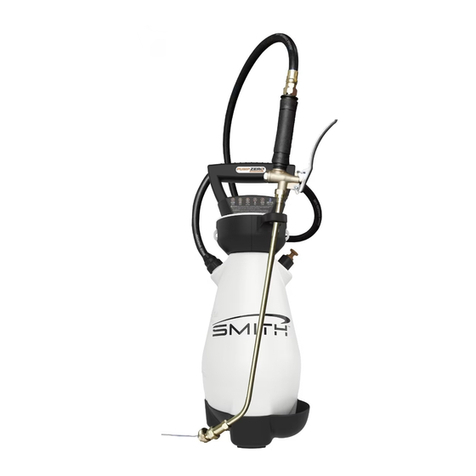
Smith
Smith XP100P User manual

Smith
Smith Bleach Sprayer User manual

Smith
Smith R200 User manual
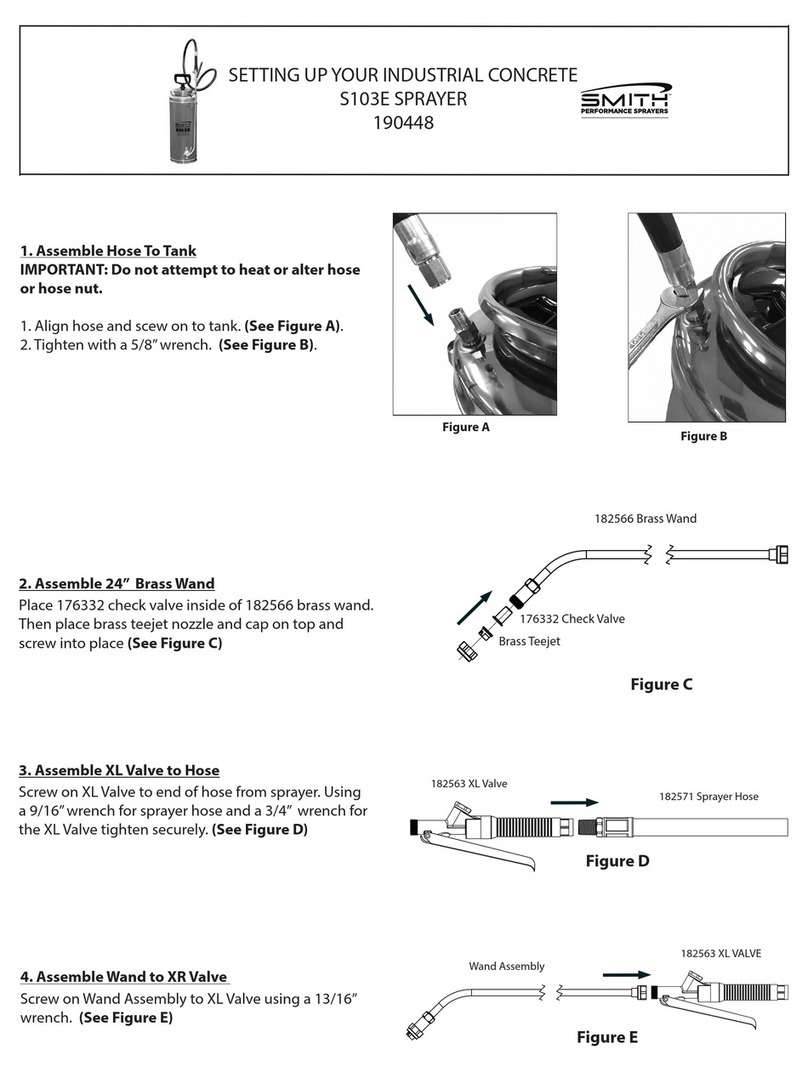
Smith
Smith S103E User instructions

Smith
Smith SR-25 Sulky Driver Operating instructions

Smith
Smith R300 User instructions
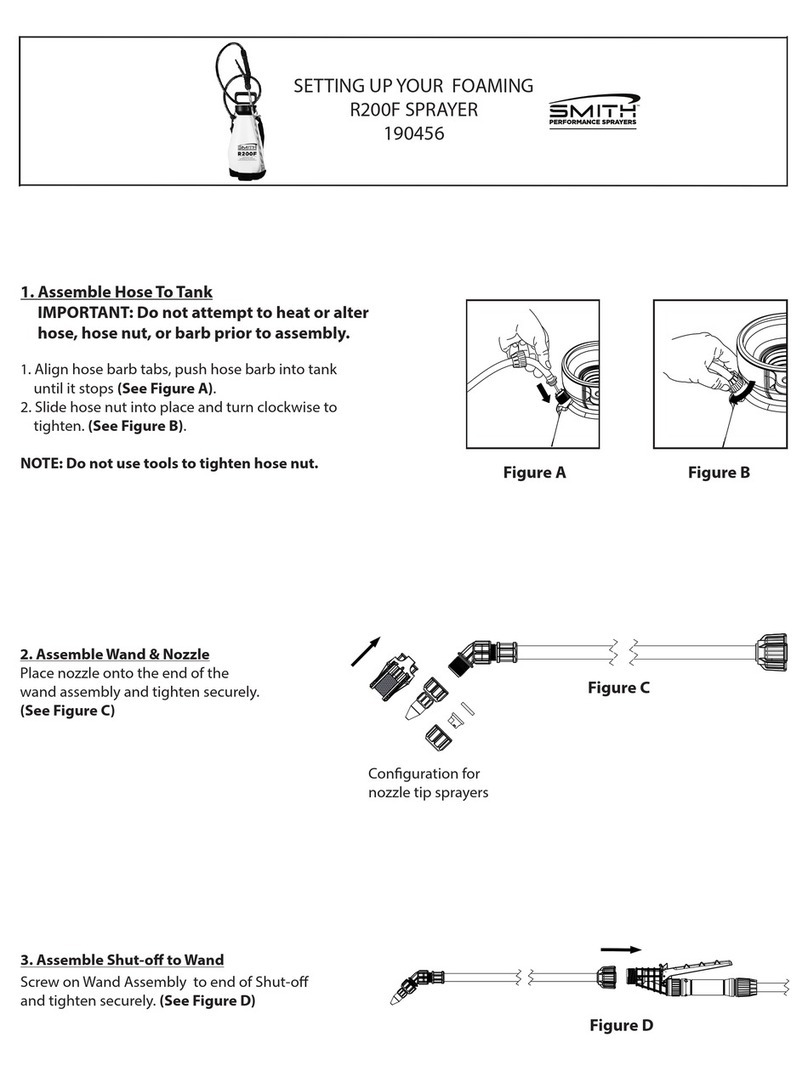
Smith
Smith R200F User instructions
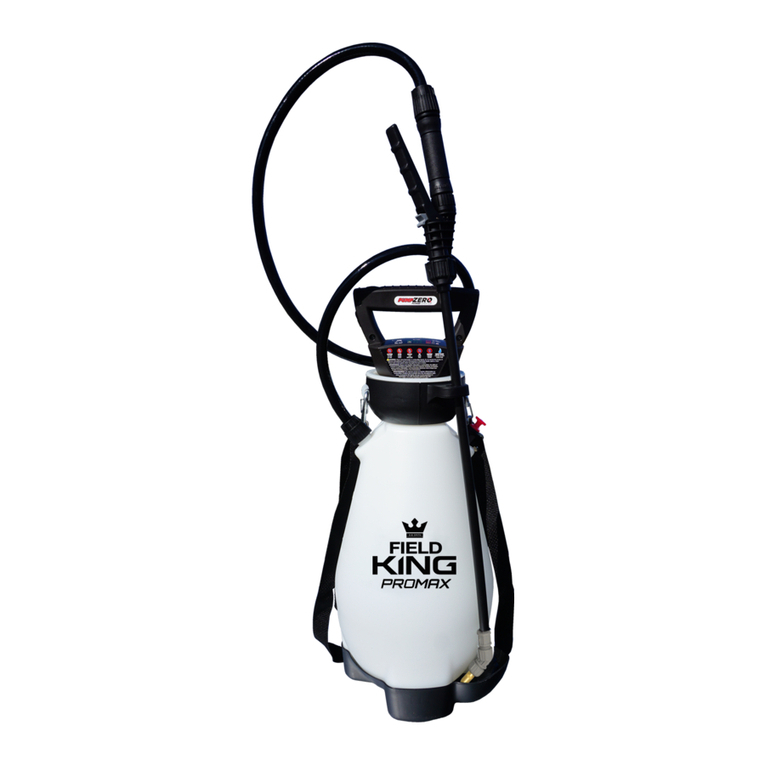
Smith
Smith R200 User manual

Smith
Smith Deck User manual

Smith
Smith R301 User manual




